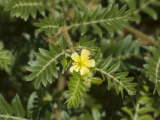Recent livestock disease cases in WA
Bluetongue ruled out in Wheatbelt sheep
- A producer reported that 20 Merino wethers in a mob of 400 grazing stubble had eye infections, appeared blind and had crusting mouth sores (Figure 1).
- Half of the animals had a thick eye discharge, were squinting and had swollen face and eyes, which caused them to appear blind. The skin on the eyelids and ears was black and leathery and the animals were jaundiced (Figure 2).
- A provisional diagnosis of unusually severe photosensitisation was made, possibly associated with caltrop toxicity as the plant was found in the paddock (Figure 3).
- Testing identified liver and kidney damage, consistent with caltrop toxicity, which can lead to photosensitisation and bacterial eye infections.
- Testing of blood and liver samples helped to rule out the exotic disease bluetongue. In the early stages, sheep with bluetongue may have fever, drooling, a nasal discharge causing crusting around the nostrils, swollen lips and tongue which may extend to include the ears, and haemorrhages of the mucous membranes of mouth, nose and eyes. Sheep may also be lame.
- Read more on bluetongue virus.
Neurological signs in dairy calves in the South-West
- Neurological signs were reported in 3-month-old, mixed sex dairy calves with 5 dead and 2 affected from a group of 19. The calves were uncoordinated and disorientated with a wide-based stance. One severely affected calf collapsed and showed a paddling movement before dying.
- The calves were on a milk and hay diet, and no other animals on the property were affected.
- The vet suspected annual ryegrass toxicity (ARGT), botulism or contamination of water supplies by toxic blue-green algae.
- Key samples were submitted to the lab including hay, water, faeces and blood.
- All faecal samples and one rumen content sample were positive for ARGT, confirming exposure. Quantitative hay testing indicated a high risk for ARGT, so animals would be likely to show disease signs if hay was a substantial part of their diet.
- Testing also ruled out a bacterial infection in the brain and lead toxicity. Neither botulinum nor blue-green algae toxins were found.
- ARGT was diagnosed. The water sample was found to be potentially too saline for dairy calves. This information will aid the producer to avoid production losses associated with water quality.
- Read more on how to prevent ARGT in livestock.
In late summer/early autumn, watch for these livestock diseases:
| Disease | Typical history and signs |
|---|---|
Ewe abortion |
|
Salmonellosis in sheep |
|
Grain overload in stock |
|
Questions about farm biosecurity or LPA accreditation? Unsure of the cause of lamb deaths on your property? Visit the DPIRD biosecurity hub at Woolorama
Do you have questions about the recent changes to Livestock Production Assurance (LPA) accreditation? Need help with your farm biosecurity plan? Queries about the animal welfare component of LPA?
Come to Wagin Woolorama, lot 626, Kitchener St where DPIRD is partnering with LPA and Livestock Biosecurity Network provide the answers. Free farm biosecurity signs will be available for producers who complete a short biosecurity quiz. Read more about farm biosecurity at Woolorama.
Producers who wish to investigate the cause of death in pre-term and newborn lambs can pick up a free sampling esky and information about the lamb deaths surveillance scheme.
Protect your livestock markets: call a vet when animals are sick
Australia’s ability to sell livestock and livestock products depends on evidence from our surveillance systems that we are free of livestock diseases that are reportable or affect trade. Data from livestock disease investigations provide evidence that WA is free from these diseases and supports our access to markets. Read more about how reporting livestock disease to a vet protects our valuable livestock markets.
Feedback
We welcome feedback. To provide comments or to subscribe to the monthly email newsletter, WA livestock disease outlook, email waldo@dpird.wa.gov.au or visit the online subscription page.

